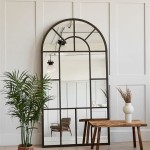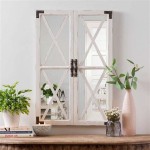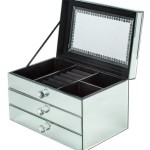Small Antique White Mirrors: A Guide to Collecting and Decorating
Small antique white mirrors offer a unique blend of functionality and decorative appeal. Their compact size makes them versatile additions to various interior design schemes, while the aged white finish adds a touch of vintage charm and history. This guide explores the allure of these charming pieces, providing insights into their history, styles, and practical uses in contemporary homes.
The History of White Mirrors
The history of white mirrors is intertwined with the development of mirror-making techniques and the evolution of interior design trends. Early mirrors utilized polished metal surfaces, but the invention of glass mirrors, backed with reflective coatings, revolutionized the industry. White mirrors, specifically, gained prominence during the 18th and 19th centuries, coinciding with the popularity of light and airy interiors. Techniques like mercury gilding and later silvering were employed to create the reflective surface. The frames, often crafted from wood or plaster, were then painted white, often with intricate detailing and embellishments, reflecting the prevalent decorative styles of the era.
The use of white paint on mirror frames served several purposes. White enhanced the reflectivity of the mirror, making rooms appear brighter and larger, a particularly desirable trait in homes before the advent of electricity. Additionally, white pigment provided a protective layer for the frame material, safeguarding it against moisture and wear. White also served as a neutral backdrop, allowing the mirror to complement various color palettes and decorative schemes.
Identifying Styles and Features
Small antique white mirrors encompass a range of styles, each reflecting the design aesthetics of its period. Identifying key features can help determine the age and origin of a piece. Chippendale mirrors, popular in the mid-18th century, are characterized by elaborate carvings, often featuring foliage and rocaille motifs. Federal style mirrors, prevalent in the late 18th and early 19th centuries, exhibit a more neoclassical influence, with simpler lines, geometric shapes, and sometimes patriotic symbols. Victorian-era mirrors frequently feature ornate detailing, including floral garlands, scrolls, and cherubs.
Examining the construction of the frame provides further clues to its age and authenticity. Hand-carved details suggest an earlier period, while molded or machine-made elements indicate later production. The type of wood used in the frame also offers insights. Mahogany, walnut, and pine were common choices for antique mirror frames. The condition of the white paint itself contributes to the mirror’s character. Craquelure, a network of fine cracks in the paint surface, is a natural result of aging and can add to the antique appeal.
The mirror plate itself offers clues to the mirror’s age. Early mirrors often exhibit slight imperfections or distortions in the reflection due to the limitations of early glassmaking techniques. The presence of foxing, dark spots or blemishes on the silvering, also indicates age. While some collectors consider these imperfections undesirable, others appreciate them as evidence of the mirror's history and authenticity.
Decorating with Small Antique White Mirrors
Small antique white mirrors offer versatile decorating options for contemporary homes. Their compact size allows them to be incorporated into various spaces without overwhelming the room. They can be used individually as accent pieces or grouped together to create a gallery wall effect. Placing a small white mirror opposite a window can amplify natural light, making a room appear brighter and more spacious. In hallways or entryways, they provide a practical surface for last-minute checks while adding a touch of vintage charm.
These mirrors can be integrated into diverse design schemes. In a minimalist setting, a simple white mirror can add a subtle touch of elegance without disrupting the clean lines. In a more traditional interior, a more ornate mirror can complement existing antique furniture and décor. They can also be used to create a focal point in a room. A small antique white mirror placed above a fireplace mantel or a console table can draw the eye and add a layer of visual interest.
Beyond their decorative function, these mirrors offer practical benefits. Their reflective surfaces can enhance the lighting in a room, making it feel more open and airy. Their compact size makes them ideal for smaller spaces where a large mirror might feel overwhelming. They can also be used to create a sense of depth and dimension in a room, particularly in narrow hallways or smaller rooms.
Collecting and decorating with small antique white mirrors offers a rewarding way to incorporate history and beauty into one's home. These elegant pieces, each with its unique story and charm, can transform a space, adding a touch of timeless elegance and character.

Antique White Wall Mirror 36cm X 55cm Flora Furniture

Sandy Antique White Rectangle Mirror 120cm X 90cm Mirrors Exclusive
Antique White Mirror Horchow

Willow Antique French Style Rectangle Mirror White Antiques Ornate

Vintage Mirror Antique White Small Grand Illusions

Rustic Wooden Framed Small Wall Mirror Decor 12 X 9 Famehouse White Mirrors For Com

Antique French Style Wall Mirror Small Country House White Rectangular Shabby Chic Mirrors

White Solid Wood Antique Rectangle Wall Mirror 30x42

Sintosin Hanging Antique Small Wall Mirrors Decorative 9 6 Distressed White Sculpted Wood Mirror Farmhouse Decor Shabby Chic Lucky Four Leaf Clover Shape For Living Room Com

Antique French Style Wall Mirror Gloria White Shabby Chic Mirrors








